|
Sur
La Rue Sans Joie
a
book and a game ~ 6 August 2005
by
Peter Hunt
If
you want to read the best, short, English account of the French Indochina
War get Bernard Fall’s “Street Without Joy”.
Although 44 years old, and although it was written with little input
from the Viet Minh side, it is still unmatched.
The title passed into the language as a metaphor for the war itself,
and for the Second Indochina War as well.
As a geographical evocation of sadness “Street Without Joy” is
probably only equalled by “Vale of Tears.”

The
book set the pattern for later popular works of military history by
interweaving historical narrative with military detail and personal
accounts. It is not a
blow-by-blow account of every action in the War.
Instead Fall adopted a narrative overview of the war that was
interspersed with accounts of the major actions and with details of smaller
actions or personal events that were typical of the war.
The eponymous chapter “Street Without Joy” is one of the latter
cases, describing not a major decisive battle but “Operation Camargue.”
This took place on 28th July 1953 as the French tried to clear
the Viet Minh (VM) 95th Regiment from the coastal plain between Hue
and Quang Tri. The 95th
had ambushed so many convoys on Route 1,
Vietnam
’s main highway running from Saigon to Hanoi, that the road was christened “la rue sans joie.”
Fall
described the terrain as several zones moving inland thus:
| Coastline |
Fairly straight with hard
sand offering no particular difficulties. |
| Dunes |
In some places stretching
two kilometers from the sea. Not
high, but very hard to climb. |
|
Graves
, Pagodas and Villages |
An area of interlocking
villages, often only 300 metres apart, that had been well fortified
with trenches, tunnels and arms depots. |
| Marshes |
Between the villages and
Route 1. These bogs
channeled the approaches to the villages on to well-defined, and
easily defended, routes. |
The French attacked this position with three amphibious task forces, two
coming from the sea and one into the village zone from the South via a salt
water lagoon; two land task forces with armoured support; and two airborne
battalions. The battle was a
classic case of Viet Minh guile and experience versus French numbers and
firepower. It was “crying
out” to be wargamed… so, at the August meeting, we did.
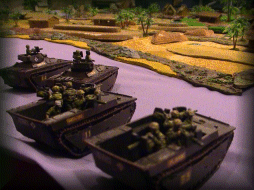 The
table was 8’ x 6’ and represented the first three zones outlined above.
There was no point in putting on the marshes but the avenues of
approach of the land task forces were limited.
Jeff reprised his role as Comrade Je, the VM overall commander
assisted by Bill. Tim, in the role of the recently demised Captain
Bonenfant’s father, Colonel Bonenfant, was the French C in C and
personally commanded the sea born amphibious units.
He was assisted by Andrzej in charge of the lagoon amphibious landing
and the Southern land thrust which included the 5th, Royal
Polish, Cuirassiers. Ken and
Andrilea commanded the Northern, mechanized task force and the paratroops.
The troops we used were not the historical ones, but what we had
available, reduced by a ratio of about 1:4 for the VM and 1:6 for the
French. The
table was 8’ x 6’ and represented the first three zones outlined above.
There was no point in putting on the marshes but the avenues of
approach of the land task forces were limited.
Jeff reprised his role as Comrade Je, the VM overall commander
assisted by Bill. Tim, in the role of the recently demised Captain
Bonenfant’s father, Colonel Bonenfant, was the French C in C and
personally commanded the sea born amphibious units.
He was assisted by Andrzej in charge of the lagoon amphibious landing
and the Southern land thrust which included the 5th, Royal
Polish, Cuirassiers. Ken and
Andrilea commanded the Northern, mechanized task force and the paratroops.
The troops we used were not the historical ones, but what we had
available, reduced by a ratio of about 1:4 for the VM and 1:6 for the
French.
The
rules used were Arty Conliffe’s “Crossfire” with the “Hit the
Dirt” supplement and my “Contre La Viets” amendments.
We also used two other amendments: long range small arms fire over
10” was subject to a “penalty dice” as explained on Lloyd Nikolas’
“Crossfire” website; and, as the dunes did not give a significant height
advantage, overhead fire was only possible within 10” of the dune, after
that line of sight was determined at ground level.
I know that the idea of using ranges runs contrary to
“Crossfire’s” design philosophy but both of these rules were to
intended stop one, well placed, HMG dominating the whole table, and they
worked well. In the event we
only had to use a tape once in the whole five-hour game to measure a range.
The
villages had been fortified, so the houses were classified as “bunkers.”
In addition to VM squads being represented by markers, with lots of
dummies to sow confusion, the villages were mapped off-table so that VM
squads, represented by counters, could move through the tunnel complexes and
houses without being seen by the French.
In Crossfire terms the VM were allowed to make retreat moves through
the tunnels even for pinned or suppressed units.
To keep things simple the VM were only allowed one squad in each
normal sized house or in each connecting tunnel section.
This worked well, and added a lot of fun to the game for the VM, and
anguish for the French.
“H”
Hour was 0630.
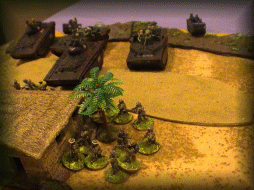 In
the Northern coastal sector Comrade Bill’s Company Commander was savouring
his first coffee of the day in My Thuy when the dunes above the little
village erupted in a chaos of caterpillar tracks, diesel fumes and tracer
rounds as the Alligators; Crabes and LVT(A) amphibious tanks of the Northern
amphibious group descended upon him. As
Vietnamese infantry debussed from the Alligators and assaulted his hut, the
commander was lucky enough to get off a burst of SMG fire to halt his
attackers at the last moment. He then disappeared into the tunnel complex to
play a cat and mouse game with the French as they attempted to clear the
village and the second line of dunes beyond. In
the Northern coastal sector Comrade Bill’s Company Commander was savouring
his first coffee of the day in My Thuy when the dunes above the little
village erupted in a chaos of caterpillar tracks, diesel fumes and tracer
rounds as the Alligators; Crabes and LVT(A) amphibious tanks of the Northern
amphibious group descended upon him. As
Vietnamese infantry debussed from the Alligators and assaulted his hut, the
commander was lucky enough to get off a burst of SMG fire to halt his
attackers at the last moment. He then disappeared into the tunnel complex to
play a cat and mouse game with the French as they attempted to clear the
village and the second line of dunes beyond.
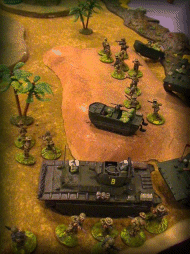 Further
South the second French amphibious group made an unopposed landing. Bonenfant
had considered a high-risk strategy of moving them quickly across the neck
of land and then into the lagoon and up into the center of the VM position.
He decided against this axis of advance, which was fortunate because
the Eastern side of the lagoon was mined.
Instead the amphibious armour swung North and commenced methodically
reducing the VM positions in Dai Lac and Lang Boa, eventually linking up
with the Northern amphibious group outside of the latter village.
This left hook was a good example of fire and movement taking out the
largely stationary VM platoons in these villages.
The French success was only marred later in the day as the French
amphibious tracks emerging from these villages, that they had entered from
the rear, used the roads that had been mined to stop them entering from the
front! Further
South the second French amphibious group made an unopposed landing. Bonenfant
had considered a high-risk strategy of moving them quickly across the neck
of land and then into the lagoon and up into the center of the VM position.
He decided against this axis of advance, which was fortunate because
the Eastern side of the lagoon was mined.
Instead the amphibious armour swung North and commenced methodically
reducing the VM positions in Dai Lac and Lang Boa, eventually linking up
with the Northern amphibious group outside of the latter village.
This left hook was a good example of fire and movement taking out the
largely stationary VM platoons in these villages.
The French success was only marred later in the day as the French
amphibious tracks emerging from these villages, that they had entered from
the rear, used the roads that had been mined to stop them entering from the
front!
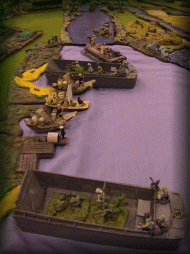 The
lagoon assault force consisted of a company of Algerians carried in LCVPs
supported by a vedette du marine patrol boat.
The LCVPs grounded outside the fishing
village
of
Lai Ha
and as their ramps splashed down a VM HMG in one of the fishing sampans
opened up on them. The .30 calibers on the landing craft quickly disposed of
the VM boat but the disembarking Algerians were then pinned down by heavy
fire from the village. Although
the Algerians suffered few permanent losses, clearing the village took the
rest of the morning. The
lagoon assault force consisted of a company of Algerians carried in LCVPs
supported by a vedette du marine patrol boat.
The LCVPs grounded outside the fishing
village
of
Lai Ha
and as their ramps splashed down a VM HMG in one of the fishing sampans
opened up on them. The .30 calibers on the landing craft quickly disposed of
the VM boat but the disembarking Algerians were then pinned down by heavy
fire from the village. Although
the Algerians suffered few permanent losses, clearing the village took the
rest of the morning.
The
patrol boat had an even less happy day.
Proceeding North through the lagoon the little vessel entered the
river leading to Van Trinh at the center of the VM position, discounting the
possibility of the river being mined. It
was, and the wrecked boat was soon heading South.
 Further
inland the Southern land task force consisted of a mixed bag of Viet Binh
Doan militia, Moroccan Goums and the
Coventry
armoured cars of the Royal Polish. Rather like the patrol boat, the militia
discounted the possibility that the most obvious approaches would be well
defended and advanced straight up the road. They were ambushed from the
paddies just South of Phu An. Whilst the Viet Binh Doan achieved little in
return for their sacrifice they had at least disclosed the VM positions in
the paddies and village which the Goumiers and armoured cars then set about
slowly, but steadily clearing. Further
inland the Southern land task force consisted of a mixed bag of Viet Binh
Doan militia, Moroccan Goums and the
Coventry
armoured cars of the Royal Polish. Rather like the patrol boat, the militia
discounted the possibility that the most obvious approaches would be well
defended and advanced straight up the road. They were ambushed from the
paddies just South of Phu An. Whilst the Viet Binh Doan achieved little in
return for their sacrifice they had at least disclosed the VM positions in
the paddies and village which the Goumiers and armoured cars then set about
slowly, but steadily clearing.
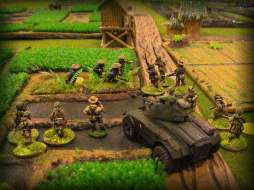 In
the North Ken and Andrilea did the right thing and debussed their infantry
from their GMCs, which were useless off-road in this sort of terrain, and
proceeded on foot with close armour support and a rolling barrage of 105 mm
artillery, to clear Dong Que. Whilst
this attack was methodically proceeding Comrade Je used his reserve from the
central
village
of
Van Trinh
to move through the tunnel systems and tree lines and launch a dramatic
counter-attack on the French vehicle laager.
The undefended vehicles were quickly torched, giving the French a
very uneasy moment. But when Je
tried to swing around on the rear of the French infantry the VM were caught
by the heavy weapons of the French Company HQ and halted on the edge of a
paddy. Suppressed, and with more
French heavy firepower being brought to bear, now it was the VM who were in
a sticky position. But in a
brilliant display of inspirational leadership (and exceptional morale dice
throwing), Comrade Je rallied his men and was able to withdraw them through
the tunnels and cover back to Van Trinh. In
the North Ken and Andrilea did the right thing and debussed their infantry
from their GMCs, which were useless off-road in this sort of terrain, and
proceeded on foot with close armour support and a rolling barrage of 105 mm
artillery, to clear Dong Que. Whilst
this attack was methodically proceeding Comrade Je used his reserve from the
central
village
of
Van Trinh
to move through the tunnel systems and tree lines and launch a dramatic
counter-attack on the French vehicle laager.
The undefended vehicles were quickly torched, giving the French a
very uneasy moment. But when Je
tried to swing around on the rear of the French infantry the VM were caught
by the heavy weapons of the French Company HQ and halted on the edge of a
paddy. Suppressed, and with more
French heavy firepower being brought to bear, now it was the VM who were in
a sticky position. But in a
brilliant display of inspirational leadership (and exceptional morale dice
throwing), Comrade Je rallied his men and was able to withdraw them through
the tunnels and cover back to Van Trinh.
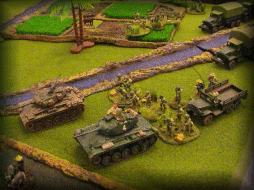 |
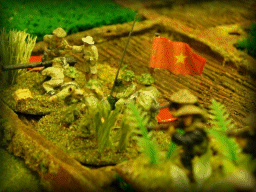 |
There
the game ended. The only thing
that hadn’t worked well was the “moving clock” which was supposed to
advance 30 minutes at the end of each VM initiative on a throw of 4, 5 or 6.
Jeff and Bill seemed incapable of getting this throw.
As a result “time” passed slowly and the French para drop
scheduled for 1030 hours didn’t get the chance to arrive.
If I did it again I would add one to the dice for each VM initiative
the clock didn’t advance so after a maximum of three initiatives it would
do so automatically.
Only
rather late in the game had the French come to realise that suppressing
fortified positions with small arms needed a lot of time and a lot of luck,
whilst close assaulting them without suppressing the defenders was quick,
but bloody. The answer was to
suppress the fortified village houses with direct fire heavy weapons ~ tank
and armoured car main guns and infantry RCLs ~ used in a “bunker
busting” role, and then winkle out the suppressed defenders.
If the defenders escaped through their tunnel systems just be
grateful that you did not have to go in after them!
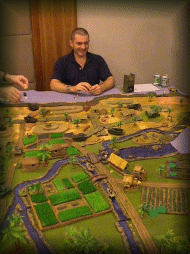 The
French had effectively cleared five and a half of the seven VM villages.
They had taken considerable losses, although they had inflicted
heavier losses on the VM. The
Northern task force had linked up with the two sea born amphibious groups
and the lagoon and Southern task forces were now in a position to push North
on Van Trinh. Thus their cordon
was about 80% complete. The VM
still had an escape route to the west from Van Trinh.
However this would have been blocked by the paras who had been
assigned to drop on “DZ Andrilea” which would have linked the Southern
and Northern land task forces and completed the encirclement. The
French had effectively cleared five and a half of the seven VM villages.
They had taken considerable losses, although they had inflicted
heavier losses on the VM. The
Northern task force had linked up with the two sea born amphibious groups
and the lagoon and Southern task forces were now in a position to push North
on Van Trinh. Thus their cordon
was about 80% complete. The VM
still had an escape route to the west from Van Trinh.
However this would have been blocked by the paras who had been
assigned to drop on “DZ Andrilea” which would have linked the Southern
and Northern land task forces and completed the encirclement.
As
it was the game was adjudged a VM marginal victory on account of the French
losses. But had we continued the
new French tactics and the airborne reinforcements would have swung the
balance more in their favour. All-in-all
honours on the “Street Without Joy” in 2005 were about equal ~ just as
they were in 1953.
back to vietnam
|